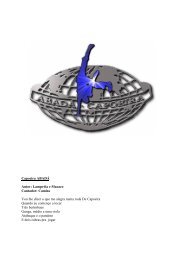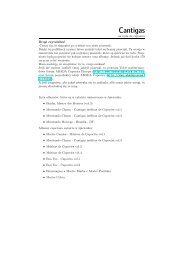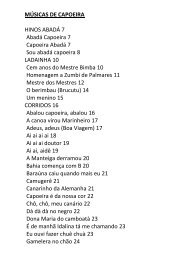A Collision of Cultures in the Brazilian Battle Dance - Capoeira Music
A Collision of Cultures in the Brazilian Battle Dance - Capoeira Music
A Collision of Cultures in the Brazilian Battle Dance - Capoeira Music
You also want an ePaper? Increase the reach of your titles
YUMPU automatically turns print PDFs into web optimized ePapers that Google loves.
6 chapter<br />
MAp 1.1. The transatlantic slave trade to Brazil, 1817–1843. University <strong>of</strong> Wiscons<strong>in</strong><br />
Cartography Lab.<br />
Cab<strong>in</strong>da played a central role <strong>in</strong> <strong>the</strong> slave trade. Besides Cab<strong>in</strong>da, several o<strong>the</strong>r<br />
ports <strong>in</strong> <strong>the</strong> same region supplied slaves to meet <strong>the</strong> <strong>in</strong>creas<strong>in</strong>g demand: Loango,<br />
Mayumba, and Malemba (Map 1.2).30 slaves from Gabon (called Gabão) and<br />
from Boma, tio K<strong>in</strong>gdom, <strong>the</strong> Zaire river, and Ubangi were all categorized as<br />
nor<strong>the</strong>rn Kongolese. The name “Congo” was commonly given to slaves from<br />
<strong>the</strong> nor<strong>the</strong>rn Congo, although <strong>the</strong> network <strong>of</strong> slave trad<strong>in</strong>g collected <strong>the</strong>m from<br />
hundreds <strong>of</strong> diverse nations along <strong>the</strong> Zaire river. slaves from Bakongo, nor<strong>the</strong>rn<br />
angola, and sou<strong>the</strong>rn Zaire were also called “Congo.” ano<strong>the</strong>r group, constitut<strong>in</strong>g<br />
about a third <strong>of</strong> all <strong>the</strong> slaves brought to rio, were known as “angola.”<br />
<strong>in</strong> <strong>the</strong> n<strong>in</strong>eteenth century <strong>the</strong> angola slaves came ma<strong>in</strong>ly from Luanda, which<br />
was at <strong>the</strong> time a major portuguese port, and from Cassange. although this area<br />
was quite small, it comprised several ethnic groups. after <strong>the</strong> British put a stop<br />
to shipp<strong>in</strong>g slaves from <strong>the</strong>re, <strong>the</strong> volume <strong>of</strong> <strong>the</strong> slave trade <strong>in</strong> <strong>the</strong> neighbor<strong>in</strong>g<br />
port <strong>of</strong> ambriz <strong>in</strong>creased. slaves known as Cassange were transported from <strong>the</strong><br />
markets <strong>of</strong> Cassange <strong>in</strong> eastern angola. The names ambaca, rebolo, Quissama,<br />
and Luanda were also well known and widespread. The Benguela, <strong>in</strong> modernday<br />
angola, constituted a separate group, <strong>the</strong> largest, brought to rio de Janeiro.<br />
They were named for <strong>the</strong>ir port <strong>of</strong> departure, Benguela, <strong>in</strong> sou<strong>the</strong>rn angola, and<br />
this port also became an important slave trad<strong>in</strong>g center after <strong>the</strong> english closed<br />
<strong>the</strong> port <strong>of</strong> Luanda to slave ships. <strong>in</strong>cluded <strong>in</strong> this category were <strong>the</strong> ovimbundu<br />
and <strong>the</strong> Ganguela.






